An exhibition at Paris’s Musée d’Orsay centers on a black model named Laure in Édouard Manet’s Olympia and reinterrogates the role of black people in art history.
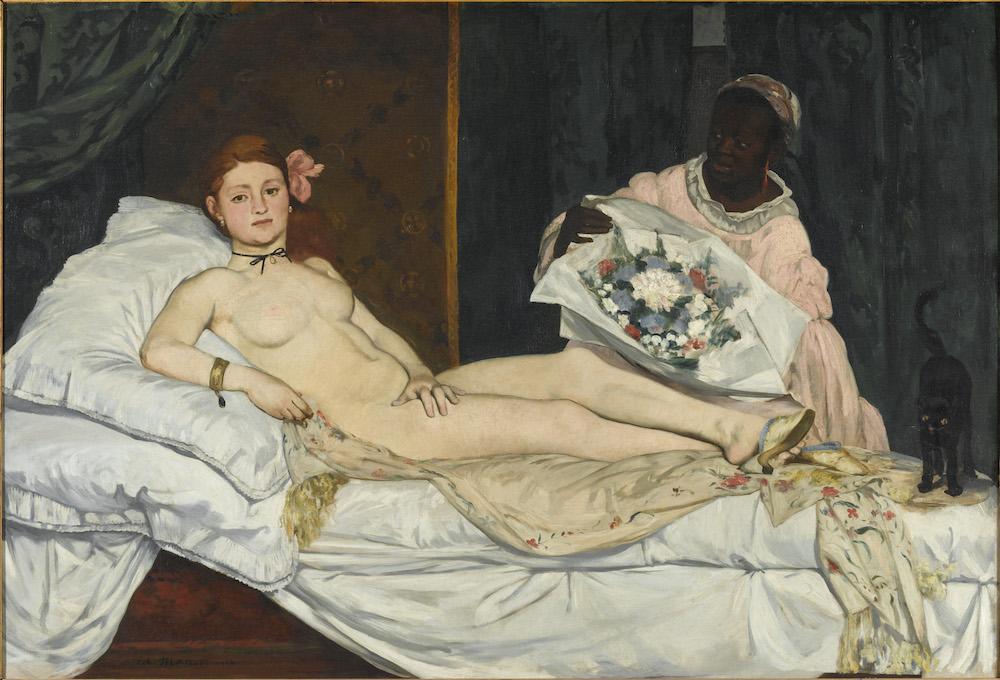
Édouard Manet, Olympia, 1863, oil on canvas, 51″ x 75″. Presented at the 1865 Salon. Paris, Musée d’Orsay, RF 644. Photo © Musée d’Orsay, Dist. RMN-Grand Palais / Patrice Schmidt.
Around the time that Édouard Manet was painting Olympia, in 1863, a liberating politics was underway in France. Napoleon III had become so distracted with foreign affairs—handling the Second French Intervention in Mexico, breaking up a burgeoning Roman Republic in order to restore the Pope’s power, and making colonial conquests throughout Central Africa, Asia, and the South Seas—that he had little time to resist many of the political pressures back home. And so he was actually carrying out some of the promises he’d made in the run-up to his Second Empire coronation, such as reducing media censorship and allowing workers to strike. By 1870, Napoleon III, under the pressure of the Liberals, even assented to a parliamentary legislature in France, which would ultimately serve as the basis of the Third Republic.
In the late nineteenth century, Paris began to seem like an integrated and relatively racially equitable city. After the 1848 Revolution, slavery had been abolished in France’s territorial colonies; Caribbean people moved en masse to the French capital. Alexandre Dumas, author of The Three Musketeers, and his father, Thomas-Alexandre—who was one of the most important black military men in European history—were viewed as unassailably prominent members of French society. Racism, of course, still existed, even at the highest levels of government: in 1884, Jules Ferry, who served as both prime minister and as president of the senate, was espousing his eugenics-based racism, saying things like, “The higher races have a right over the lower races … a duty to civilize the inferior races.” But for a moment, the scene seemed to be set for a fresh form of liberty and relative equality.
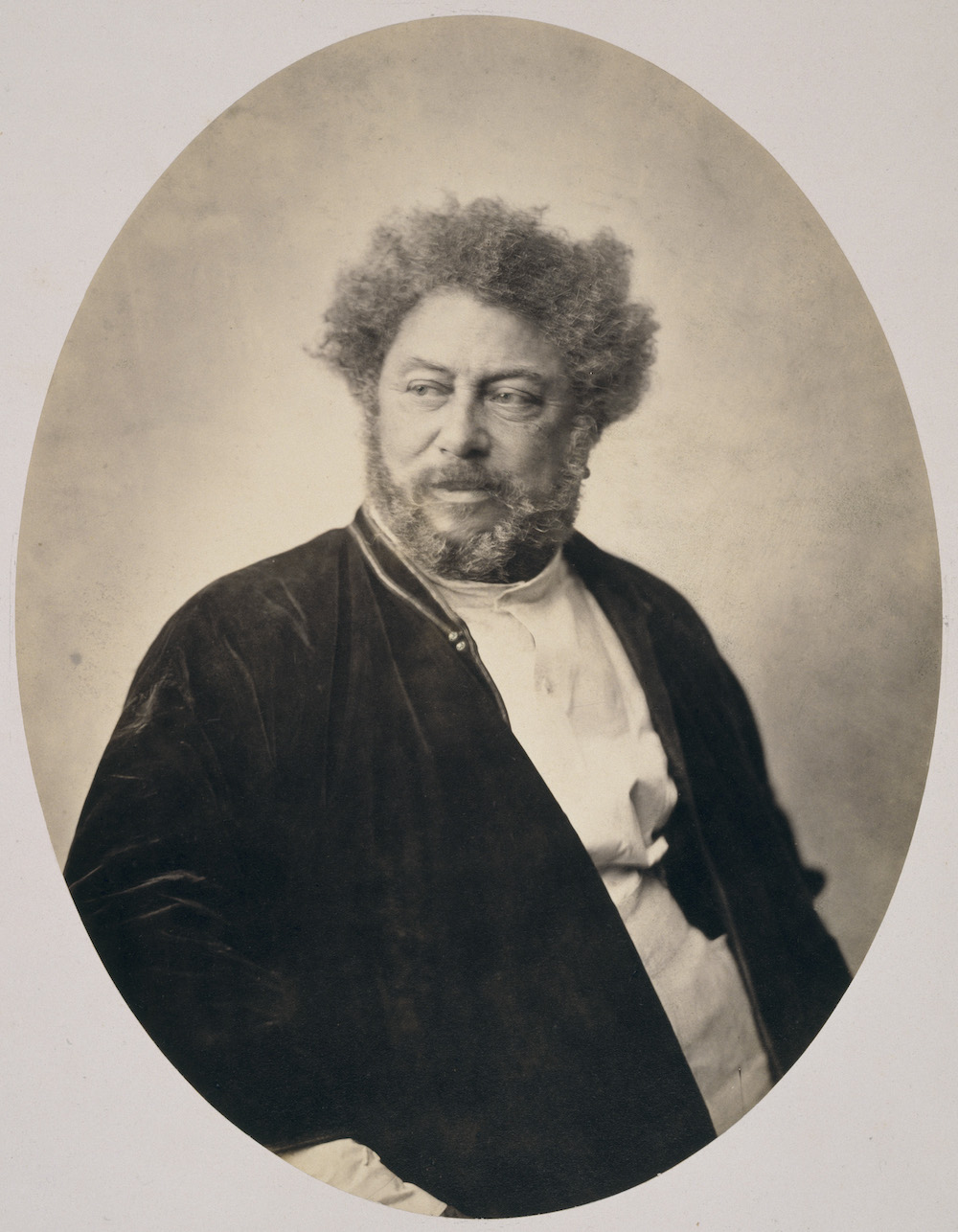
Gustave Le Gray, Portrait d’Alexandre Dumas en costume russe, 1859, oval proof laminated on gray paper, itself laminated on cardboard, 10″ x 7 1/2″. Paris, Musée d’Orsay, PHO 1986 11. Photo © RMN-Grand Palais (musée d’Orsay) / image RMN-GP.
Art, naturally, was both driver and recipient. The poet Charles Baudelaire was dating Jeanne Duval, a French Haitian actress so beautiful she was often called the Black Venus and was painted by Manet. Manet, meanwhile, was fashioning himself as a recorder of the contemporary social scene. A number of his paintings depicted the black people who had immigrated to the northern neighborhoods of Paris. In his studio notebook, he described the black maid whom he painted standing next to the lounging white prostitute in Olympia and the black caregiver in his Children in the Tuileries Garden (1862) as “Laure, très belle négresse, rue Vintimille, 11, 3éme étage.” Manet’s depiction of Laure wasn’t exoticized—not the kind of nude caricature that had been standard of European depictions of black women. Instead, with her voguish neckline and bouquet of flowers, Laure modeled a typically “white role,” as a clerk in a department store or a server at a café. Also: whereas in Titian’s Venus of Urbino (ca. 1532), a clear forerunner of Olympia, the maid, who is white, is turned away from the nude, lounging women in the foreground; in Olympia, Laure is just as much a part of the scene, in both the amount of the canvas she takes up and her foregrounded placement.
A few years ago, Denise Murrell, an African American woman studying for a doctorate in art history at Columbia, found that excerpt about Laure in Manet’s studio diary. Murrell was studying the depiction of black women from Olympia—the painting that is often considered the founding work of Modernism—to the modern day. Murrell’s dissertation, which she completed in 2013, served as the basis of the exhibitions “Posing Modernity: The Black Model from Manet and Matisse to Today,” which she curated at the Wallach Art Gallery in New York, and “Black Models: From Géricault to Matisse,” which is currently on at the Musée d’Orsay in Paris as an expanded iteration of the New York exhibition. (The Orsay exhibition includes a number of works on view only in France, like Olympia. Murrell co-curated the Orsay show, along with Cécile Debray and Stéphane Guégan.)
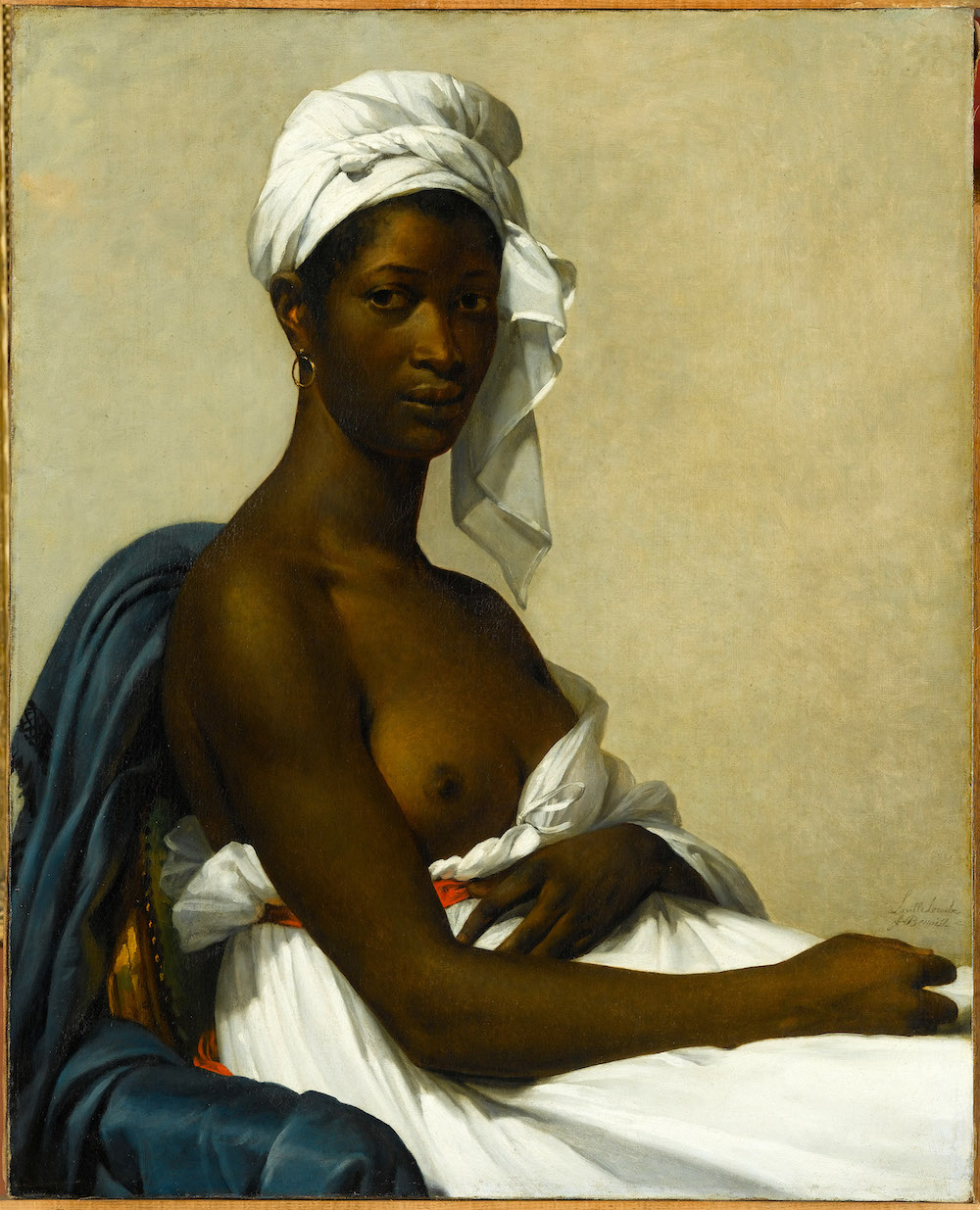
Marie-Guillemine Benoist, Portrait de Madeleine (also known as Portrait d’une femme noire), 1800, oil on canvas, 32″ x 25 1/2″. Presented at the 1800 Salon. Paris, Musée du Louvre, INV 2508. Photo © RMN-Grand Palais (Musée du Louvre) / Gérard Blot.
The Orsay exhibition includes paintings of black women by Manet, Géricault, Matisse, Delacroix, Gauguin, Picasso, Bonnard, and Cézanne. Marie-Guillemine Benoist’s Portrait of a Negress has been, in this exhibition, temporarily renamed Madeleine, after the black model’s name, an act of humanization. But it is Laure, Manet’s model, who is at the center of both the Orsay exhibition and Murrell’s dissertation—a founding symbol of the overlooked centrality of black women in Modernism.
“The small body of published commentary about Manet’s Laure, with a few notable exceptions, generally dismisses the figure as meaning, essentially, nothing—except as an ancillary intensifier of the connotations of immorality attributed to the prostitute,” Murrell writes in her dissertation. She suggests, however, that Laure demonstrates that the history of Modernism is also, in part, the history of an “evolving cultural hybridity.” Ultimately, she writes, “what is at stake is an art-historical discourse posed as an intervention with the prevailing historical silence about the representation and legacy of Manet’s Laure.” “The black female figure,” she concludes, “is foundational to the evolving aesthetics of modern art.”
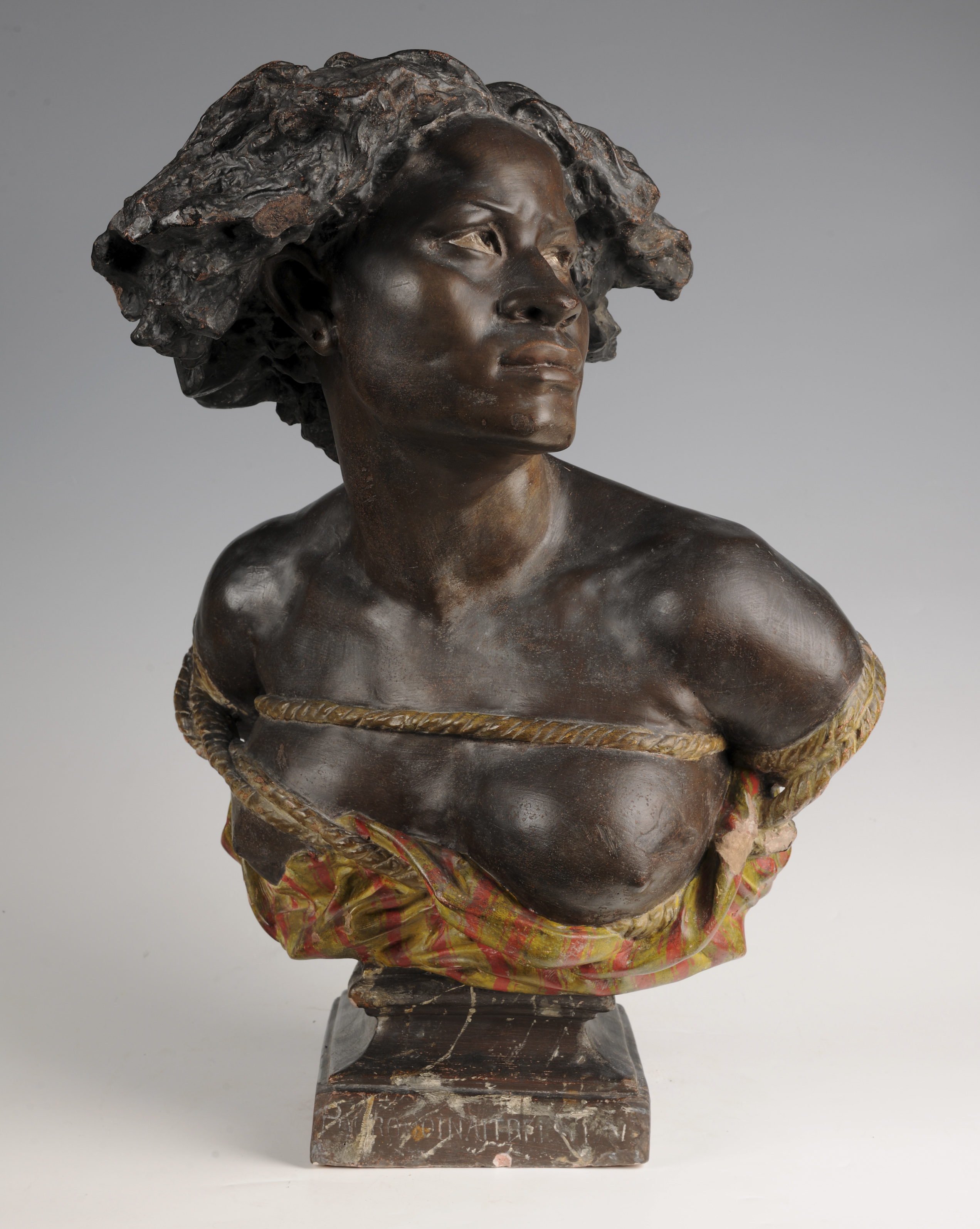
Jean-Baptiste Carpeaux, Pourquoi naître esclave?, after 1875, polychrome plaster, 24″ x 18″ x 14 1/2″. Reims, Musée des Beaux-Arts, 941.1. © Musée des Beaux-Arts de la Ville de Reims.
It’s a similar idea to that championed by the artist Lorraine O’Grady in her seminal 1992 paper “Olympia’s Maid: Reclaiming Black Female Subjectivity,” in which she argues that black models are far more than formal constructs, as was often claimed—their color meant to bring to the fore the white models in contrast. Olympia was indeed a formally revolutionary artwork in its flatness and the washed-out color of the white woman in the foreground. But as O’Grady hints, and as pointed out by the doctoral student Kaegan Sparks, Laure’s blackness also blends into the background, creating, as Sparks writes, a kind of “proto-abstraction,” another tenant of this nascent Modernism.
Placing black models at the center of—and the beginning of—Modernism also works to overturn the idea that high art is the sole purview of white, European culture. “One of the central claims to European supremacy,” writes Kehinde Andrews, a professor of black studies at Birmingham University, is that “art galleries and museums are the embodiment of whiteness—at times, it seems, conceived solely to prove that ‘high’ culture is the possession of those of European descent.” This remains a core claim of conservative thinkers today and is the not-so-subtle implication of those who cling to so-called Western values.
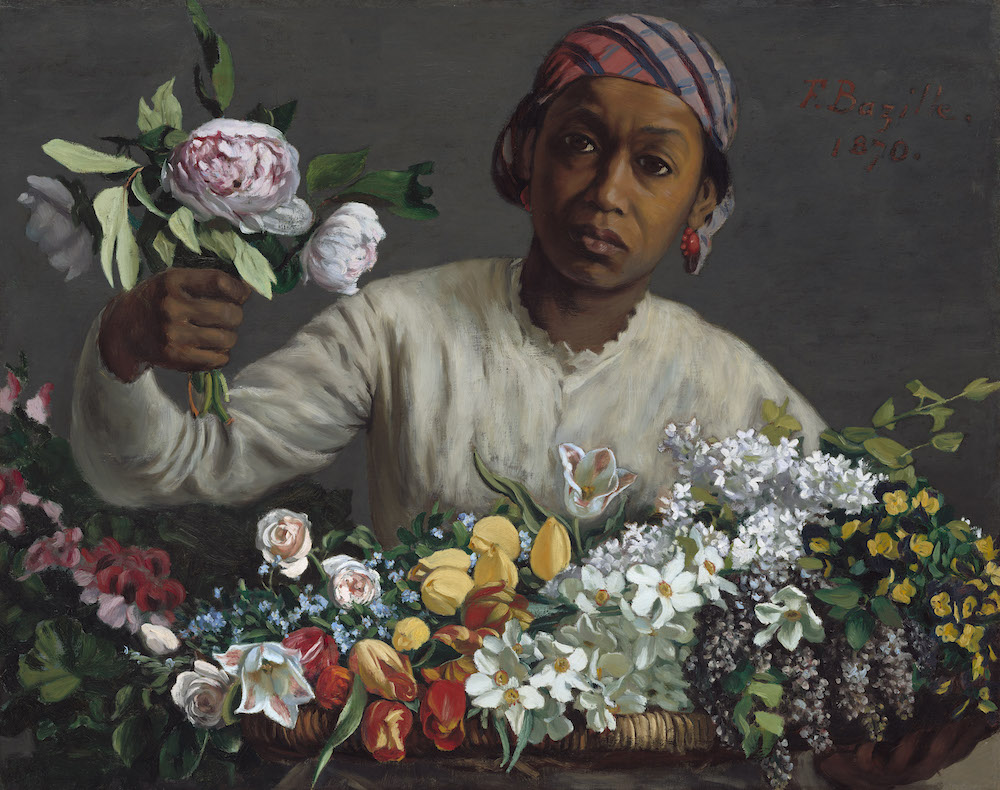
Frédéric Bazille, Femme aux pivoines (originally titled Négresse aux pivoines, 1870, oil on canvas, 23 1/2″ x 29 1/2″. Washington, National Gallery of Art, collection de M. et Mme Paul Mellon, 1983.1.6. © Courtesy National Gallery of Art, Washington, NGA Images.
For a long time, and even very recently, artworks with black models—or by black artists—were collected sparingly by museums, in part because they weren’t considered to fit into any standard art-historical narratives. Between 2008 and 2018, for instance, only 2.4 percent of purchases and donations in thirty of the best-known American museums were works by African American artists, according to an analysis by In Other Words and ARTNews. Only 7.6 percent of exhibitions concerned African American artists. From Modernism through postwar Abstract Expressionism, work by black painters still represented a catch-22: they were either too much about the black experience and thus didn’t seem to fit into the European timeline of art history, or they were too reliant on the abstract when the few museums that did collect black artists wanted figurative works that represented “the black experience.” “It’s pretty hard to explain by any other means than to say there was an actual, pretty systemic overlooking of this kind of work,” said Ann Temkin, the curator of painting and sculpture at the Museum of Modern Art in New York, in a recent interview.
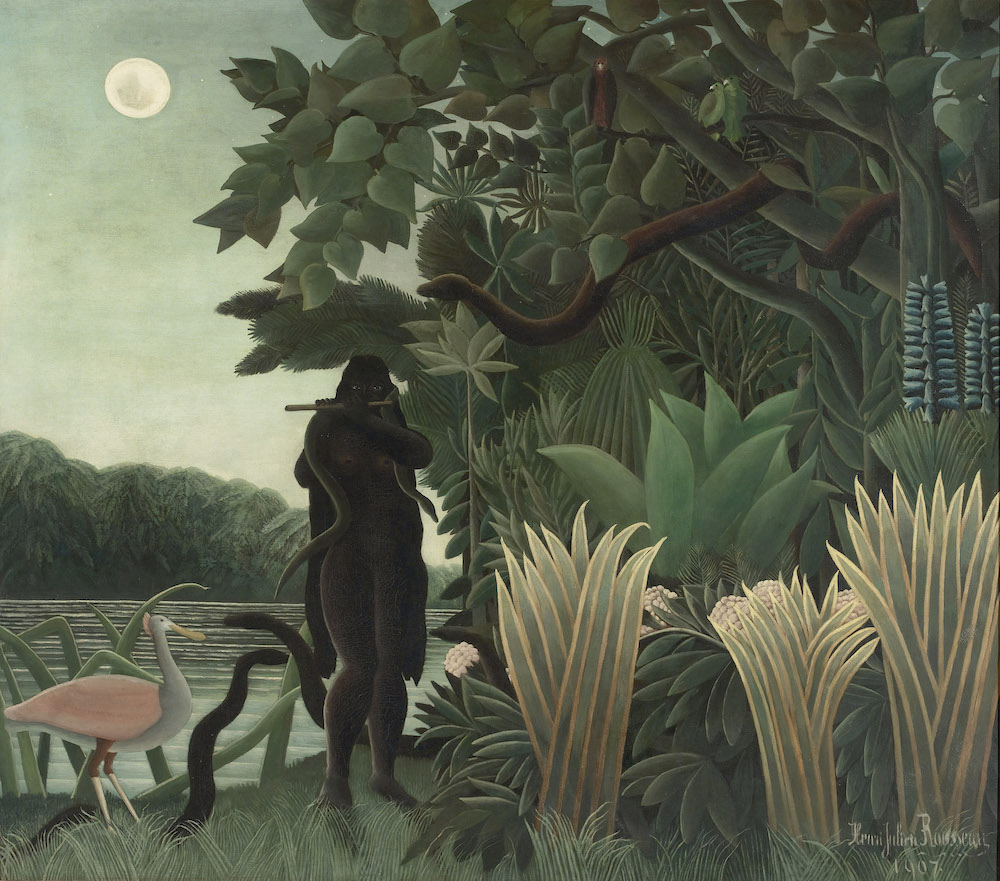
Henri Rousseau, La Charmeuse de serpents, 1907, oil on canvas, 66″ × 74 1/2″. Paris, musée d’Orsay, RF 1937 7. Photo © Musée d’Orsay, Dist. RMN-Grand Palais / Hervé Lewandowski.
To upset this rigid art history, therefore, has been a great—and recent—feat. The Orsay show isn’t quite the solution it could be. It is not so radical as to be only about black artists, since the artists depicting black people are mostly white, but it functions as an impressive and vital bridge, placing black figures at the center of European art history. It also comes on the heels of a recent rise in interest in black artists by museums. Between 2018 and now, there’s been a significant uptick in exhibitions centered on African American artists, thanks in part to the rising popularity of the Obamas’ portraitists, Amy Sherald and Kehinde Wiley, as well as to increasingly market-friendly African American artists like Mark Bradford, who represented the U.S. at the previous Venice Biennial, in 2017, and the enigmatic David Hammons, whose current show at Hauser and Wirth in Los Angeles is a marvel in both beauty and marketing strategy. (His last major exhibition was in 2000 at the Prado in Madrid, and rumor has it that part of his reason for choosing Hauser and Wirth for this current exhibition, “Harmolodic Thinker,” was that the gallery agreed to pre-purchase all of the works to be shown. But again: rumor …)
The market has been instrumental in bringing black artists to the fore: it is now a financial risk for museums and individuals not to collect work by black artists. Just a few years ago, a collector (or a museum) could have gotten a large, collaged work by Bradford for under a million dollars. Today, one would be lucky to get that kind of Bradford at auction for under ten million. Hammons, a few years ago, sold a basketball-hoop chandelier for $8 million, Sam Gilliam’s Lady Day II realized $2.17 million at Christie’s last fall, and then there’s Jean-Michel Basquiat, an almost impossibly bankable artist. From a market perspective, African American male artists have been on a precipitous rise.

Henri Matisse, Dame à la robe blanche (femme en blanc), 1946, oil on canvas, 38″ x 24″. Des Moines, Des Moines Art Center, 1959.40; donated by M. John et Mme Elizabeth Bates Cowles. © Photo: Rich Sanders, Des Moines, IA. © Succession H. Matisse.
It seems strange, then, to think about how long even basic facts about the relationship between blackness, black culture, and certain Modernists, like Manet and Matisse, have been omitted from the timeline of art history. Matisse, the exhibition shows, was enormously inspired by the Harlem Renaissance when he visited New York throughout the thirties. He had a great love for black theater and for jazz, and it’s clear in the exhibition, albeit ultimately circumstantial and implicit, that Matisse found inspiration in African American art. To illustrate the 1947 edition of Baudelaire’s famed poetry collection Les fleurs du mal, Matisse enlisted black models like the Haitian dancer Carmen Lahens to act as his model and muse.
The Orsay exhibition concludes with recent works by black women artists like Elizabeth Colomba and Ellen Gallagher. The implication is that, today, black women, rather than merely being depicted, are now wielding the brush, controlling their own narrative. As we enter a time of decreasing liberalization with more and more checks placed on women’s bodies—and increasingly overt racism condoned by governments from the U.S. to Hungary to Brazil and beyond—it’s vital to realize that black women have always been a part of the art-historical narrative. It’s just that now galleries and museums are finally beginning to make a space for the history that was there all along.

Jean-Léon Gérôme, Étude d’après un modèle féminin pour « À vendre, esclaves au Caire », ca. 1872, oil on canvas, 19″ x 15″. Private collection. © Photo courtesy of Galerie Jean-François Heim – Bâle.
Cody Delistraty is a writer and critic in Paris and New York.
from The Paris Review http://bit.ly/2HZeMEi
Comments
Post a Comment